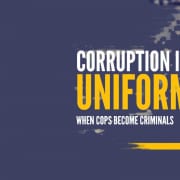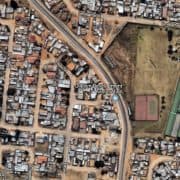|
Getting your Trinity Audio player ready...
|
In 2017 we released our first Analysis of Corruption Trends (ACT) report, which identified five common areas where corruption frequently occurs – in schools, local municipalities, the South African Police Service (SAPS), licensing centres and traffic departments.
This year’s ACT report, titled It’s Time to Act, shows more of the same. More abuse of power entrusted to individuals and institutions in both the public and private sectors. More bribery, more police-related corruption, more procurement irregularities. More schools corruption – but with the added and unwelcome element of sextortion. More municipal corruption and theft of resources. A new trending area – the health sector.
Although the overall statistics we present are lower than the previous edition, the outlook is not encouraging. However, as was the case last year, there is an on-going positive trend of whistle-blowing around the country. We are heartened by the fact that almost 2 500 whistle-blowers shared their experiences with us. They are ordinary men and women with whom the message of cultivating a corrupt-free society resonates. They are fathers, mothers, grannies, grandpas, uncles, aunts, and children.
These people cared enough to pick up a phone to call or message Corruption Watch when they saw that a public official was skimming from the state. It should encourage us all that people of all walks of life saw it as their responsibility to visit Corruption Watch’s offices when a shady business enterprise sought to feed off the state at the expense of tens of millions of poor South Africans’ lives.
Moreover, we need to see corruption for what it truly is – a malignancy, a devious act of immorality that harms all over a long period, but a problem that we most certainly can overcome just as long as we remain vigilant and firm in our efforts to encourage and protect whistle-blowers.
The numbers don’t lie
Compared to the 2 744 reports of corruption submitted to us in the same period last year, we received 2 469 reports in the first half of 2018. The vast majority of those (39.8%) came from Gauteng province, followed by KwaZulu-Natal and then the Western Cape and Eastern Cape in joint third. This is more a factor of Corruption Watch’s work centred mostly on Gauteng, as well as the province’s population size and level of economic activity, than one of its relative level of corruption.
Of the country’s big metros, the City of Johannesburg generated 20.1% of reports, followed by City of Tshwane with 10.1%, and City of Cape Town and Ekurhuleni with 6.0% apiece. Reports from metros account for 52% of all reports received, compared to under 50% last year.
The trending issues for 2018 were schools, municipalities, SAPS, licensing centres, state owned entities, and the health sector. Together these areas count for 36.1% of the cases of corruption received, and the most common forms of corruption they presented were bribery, irregularities in procurement, the embezzlement of funds and theft of resources, and employment irregularities.
Schools corruption
As far as corruption in schools is concerned, the trend continues with 10.8% of the cases of corruption received in the first half of 2018 featuring principals, school governing body (SGB) members and staff members conspiring and colluding to rob schools of funds and resources or to flout procurement and employment processes. Their sole goal appears to be creating favourable conditions for acquaintances, friends and relatives who seek procurement deals and employment opportunities.
In 35.5% of our schools reports, we noted embezzlement of funds and theft of resources. Another 7.9% of cases pertained to the mismanagement of school funds. We also heard how principals at known “no-fees” schools blackmail parents or guardians into paying school fees, by victimising their children should the caregivers be unable to comply with this demand.
Then, another 3.1% of corruption cases featured sextortion – criminal activity involving teachers and principals who are said to solicit sexual favours from learners, to award them with higher marks or promote them to the next grade.
Local government and licensing
Corruption in municipal offices around the country accounted for 9.2% of the reports Corruption Watch received during the period under review – an increase of 2.6% when compared with 2017’s six-month data. In addition, 3.3% of cases spoke directly to corruption in licensing centres – an aspect of governance that is administered at the local government level.
Most reported cases (45.3%) involved procurement irregularities.
South African Police Service
Corruption Watch received numerous reports that alleged serious abuse of power, bribery, and careless behaviour by police officers. These cases, constituting more than 6.3% of the total number of corruption cases received in this six-month period, showed a disturbing connection between the abuse of power, bribery and dereliction of duty complaints.
The majority of police corruption cases – 41.3% – involved abuse of power, while 17.3% involve dereliction of duty. Meanwhile, 28.9% of cases suggested that officers accept bribes from suspects who wish to have a docket tampered with or destroyed. In other instances, perpetrators of crimes paid officers to look the other way when there is drug dealing, burglaries and car thefts.
State-owned entities
Although we did not examine this area in the first ACT report, the increased number of reported cases of corruption in SOEs necessitated a spotlight on these companies that are most crucial to South Africa’s economy.
The bulk of the corruption cases – 44% – indicated irregularities in procurement in SOEs. Going hand-in-hand with these claims were the 20.3% of cases pertaining to bribery, which does not only take monetary form – officials are sent on expensive holidays and their lavish lifestyles are catered for.
Corruption in the health sector
Although only 2.7% of our reports focused on this trending corruption area, the seriousness of the offences shows in the very fact that the health of ordinary South Africans was compromised through corruption. As with other sectors, we noted bribery and irregularities in procurement and employment as the main types of corruption in the health sector.
According to the allegations of bribery, comprising 22.8% of the corruption cases, officials in hospitals and clinics solicited bribes from job seekers and companies bidding for goods and services contracts. In terms of the former, Corruption Watch understands that job applicants called to formal interviews were told that recruitment could only be secured through a facilitation fee, while other bribes related to securing tender contracts.







